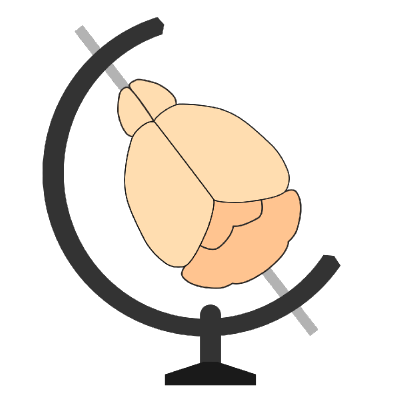BrainGlobe version 1 overview#
BrainGlobe version 1 provides users with the brainglobe “meta”-package: a single package that will fetch all the tools in the BrainGlobe suite and install them onto your machine, ready for use.
It also provides the brainglobe-workflows package, which builds on top of brainglobe and provides some common analysis pipelines to users, as well as a benchmarking suite for developers working on code performance improvements.
If you want to know more about the under-the-hood workings of the brainglobe “meta”-package, you can head to the developer documentation.
Updating to version 1#
Our recommendation for updating to BrainGlobe version 1 is to follow the installation instructions on the main documentation page in a clean virtual environment, and delete or archive your old environment.
This will ensure that when you install brainglobe, the tools are fetched in a consistent manner and do not pick up any manually installed BrainGlobe tools that might be in your environment or python path.
Likewise, it also avoids potential issues when tools have been installed from both conda-forge and PyPI.
If you don’t want to install the entire BrainGlobe suite and are happy to manage the tooling interdependencies yourself, you can still manually install the individual BrainGlobe tools that you wish to use.
Can I install from conda-forge?#
We are working on providing a conda-forge install for BrainGlobe version 1, as an alternative to the pip install brainglobe command that we currently recommend.
However for the time being, there is no one-line installation possible using conda.
There are no problems with pip install brainglobe-ing into a conda environment, we just need some time to setup all of the individual BrainGlobe tools on conda-forge before we can provide an all-in-one install through conda!
Changes at-a-glance#
Below is a high-level overview of the changes to the brainglobe suite of tools that we offer. You can follow the links provided for more information; including a listing of relocated and/or renamed tools.
Change |
|
|---|---|
brainreg and brainreg-napari have been merged into a single package |
|
brainreg-segment has been renamed to brainglobe-segmentation |
|
The |
|
The cellfinder package is deprecated - it will later be recycled to merge some backend functionality |
|
The cellfinder Docker image is discontinued |
|
cellfinder-core and cellfinder-napari merged into “new cellfinder” |
|
The cellfinder command-line tool has been replaced with |
|
|
Full Changelog#
Recommended BrainGlobe install is via pip, into a clean environment.
pip install brainglobeto install BrainGlobe tools. Recommended even if you only want to use one or two tools.pip install brainglobe-workflowsif you also want to use the example analysis workflows that we provide.
brainreg-napariis now shipped withbrainregbrainregfunctionality is now available in a submodule,brainreg.core. If you previously used the Python API provided inbrainreg, you will need to change yourfrom brainreg import Xstatements tofrom brainreg.core import X.The
brainreg-napariplugin is now just calledbrainregwhen usingnapari. The plugin’s backend is in the submodulebrainreg.naparirather thanbrainreg-napari.The new
brainreg.coreandbrainreg.naparisubmodules retain the old internal structure of the respective deprecated packages.
brainreg-segmenthas been renamedbrainglobe-segmentation.Beyond the name change, package internals have not changed.
cellfindercommand-line-interface (CLI) has been renamed and moved.The command-line interface is now provided by
brainglobe-workflows.The command-line tool is now called
brainmapper.The name “cellfinder” is now reserved for the merged
cellfinder-coreandcellfinder-naparipackages.
cellfinder-coreandcellfinder-naparihave been merged into a single package, calledcellfinder.The
cellfinderpackage should not be confused with the old cellfinder command-line tool, described above. Going forward, “cellfinder” will refer exclusively to this new, merged package created fromcellfinder-coreandcellfinder-napariwhich only performs cell detection. The command-line tool will use the namebrainmapper.The
coreandnaparifeatures are now available as submodules of thecellfinderpackage. If you previously usedfrom cellfinder_core import X, you’ll have to usefrom cellfinder.core import Xinstead.Internal function names and locations have otherwise not changed, beyond their conversion into the
coreandnaparisubmodules.The napari plugin is now referred to as the
cellfinderplugin, and shows up with the namecellfinderwhen viewed in napari (as opposed to the oldcellfinder-napariname it used to have).
brainglobe-workflowshas been released.This package provides some exemplar data analysis workflows for users to modify or customise to suit their needs.
It will also provide command-line interfaces for particularly common workflows. Currently it provides
brainmapper, the successor to the old cellfinder command-line tool.
pip install brainglobeis now the recommended way to install all BrainGlobe tools.This will fetch the
brainglobemeta-package, which includes the latest stable versions of all BrainGlobe tools and napari plugins.All tools will be accessible in the install environment as if they had been pip-installed directly.
If you are updating to
brainglobeversion 1 having previously installed BrainGlobe tools individually, we recommend you create a clean Python environment and installbrainglobeinto this fresh environment to avoid potential package conflicts.brainglobepackage now ships the fixedbrainrender, as well asbrainrender-napariwhich we plan to transition to in the future.
